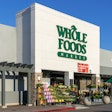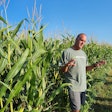
Trick-or-treaters aren’t the only ones who get to enjoy Hershey’s chocolate products this Halloween. Cows get candy meal in their feed all year round as part of a sustainability partnership between The Hershey Co. and Cargill.
As part of a circular system, some of the cows that produce the milk for the chocolate also consume feed made from discarded Hershey products that would otherwise go to landfills.
Cargill’s plant in Chambersburg, Pennsylvania, is dedicated to this upcycling effort, turning tens of thousands of Hershey’s chocolate waste per year into feed ingredients for cows, pigs and other species, according to the company. The project started in 2011 when Hershey’s approached Cargill.
“When it came to finding a partner to help us with this process, we knew that trust and technology were two critical factors,” said Eric Boyle, senior director of commodities and procurement at Hershey. “After careful consideration, we realized that Cargill was the perfect fit. Not only could we trust them to handle the process safely, but their advanced technology made them the clear choice for us.”
Candy meal is the finished product made of a combination of Hershey waste and various dry feed ingredients. Darryl Reiner, a senior merchant at Cargill, was already purchasing products from customers like Hershey when the partnership idea started.
“I was buying candy meal for some of our plants at the time and knew the value of it,” he said. “So, when Hershey asked us to take over their candy meal production, we knew it was a safe bet. Once we got ahold of it, we could tweak and make it even better.”
This is the process, according to Cargill’s website:
- The Cargill Letterkenny plant in Chambersburg receives big cardboard boxes from various Hershey facilities. In those boxes are things like chocolate and licorice bits — as well as wrappers that its team has to separate.
- Once that’s done, Cargill recycles the cardboard and compacts what it can before shipping the wrappers and excess off to an incinerator to be turned into energy.
- From there, the edible portions are allowed to dry out naturally, then are shredded and grinded into smaller particles and mixed with the dry feed ingredients.
- Then the nutritional value of the candy meal is fine-tuned and undergoes quality control.
Sugar is an important energy source for cows, but it is an expensive ingredient. Candy meal is an ideal substitute for sugar because it has high sugar content, as well as fat and protein.
The process also significantly reduces waste going to a landfill and helps the companies meet their sustainability commitments.
“It’s a win-win for everyone — Hershey, the environment, our customers and Cargill,” Reiner said.

















